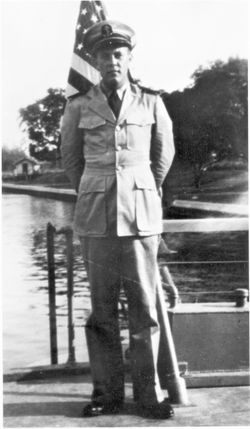Sibling: Margaret Ackerlind
~~~.~~~.~~~.~~~.~~~.~~~.~~~.~~~.~~~
U.S. Merchant Marine
Class: 1943, King's Point
Service No: B 42102
Significant Awards: Atlantic War Zone Bar, Victory Medal, Presidential Testimonial Letter.
Address of Record: Minneapolis, Minnesota
July 7, 1942, Mobile Alabama. Edward Joseph Ackerlind signed on the SS Maiden Creek as Engine Cadet. He was 22 years old and the 23 year-old Maiden Creek, an American-owned WWI cargo vessel, commonly called a 'Hog Islander,' was his first ship.
November 11, 1942, New York. Cadet Ackerlind was on board as the Maiden Creek left New York with a cargo of barrels of aviation gasoline, bound for an Army Air Corps airfield in Greenland.
December 15th. After a scheduled stop on the return trip to New York, the Maiden Creek left Botwood Newfoundland. Sailing in convoy, they encountered a violent storm and the ship was unable to keep up. On the 19th, it was diverted to Halifax, Nova Scotia, arriving on the 22nd. Upon inspection, extensive flooding was found in various areas of the vessel, and the cargo of ore concentrates had shifted, causing the ship to list.
December 27th. After pumping out and securing all areas, except the number 1 hold, which could not be pumped due to the nature of the cargo, the ship left Halifax with 14 other vessels. On the 28th, the ships joined Convoy ON-152, bound for New York. As the convoy was nearing its destination, rough weather and turbulent seas resumed. On the 31st, the hatch covers for both number 1 and number 2 holds were found to be leaking, eventually causing the ship to take on enough water to bring the propeller and rudder out of the water.
At this point, with the Maiden Creek virtually adrift, they were about 70 miles south of Block Island (Rhode Island, USA). Around 5:00 pm, an SOS was sent out and the order was given to abandon ship. The number 3 lifeboat was launched first with Cadet EDWARD J. ACKERLIND, 17 other crew members and 5 U.S. Navy Armed Guards on board. A second lifeboat was launched about 30 minutes later with all but two of the remaining men, for a total of 31. The two Able Seamen who were still on the Maiden Creek were not able to make it down to the lifeboat; one drowned when he fell into the water and the other went down with the ship.
Aside from the storm and heavy sea, night was beginning to fall, making it all but impossible for the two lifeboats to stay together, and eventually, they lost all contact with each other.
January 3rd. Late in the day, the MS Staghound was able to finally rescue the 31 men in the second lifeboat to be launched.
The first lifeboat (number 3), with Cadet Edward J. ACKERLIND and 22 other men, was never found.
Sibling: Margaret Ackerlind
~~~.~~~.~~~.~~~.~~~.~~~.~~~.~~~.~~~
U.S. Merchant Marine
Class: 1943, King's Point
Service No: B 42102
Significant Awards: Atlantic War Zone Bar, Victory Medal, Presidential Testimonial Letter.
Address of Record: Minneapolis, Minnesota
July 7, 1942, Mobile Alabama. Edward Joseph Ackerlind signed on the SS Maiden Creek as Engine Cadet. He was 22 years old and the 23 year-old Maiden Creek, an American-owned WWI cargo vessel, commonly called a 'Hog Islander,' was his first ship.
November 11, 1942, New York. Cadet Ackerlind was on board as the Maiden Creek left New York with a cargo of barrels of aviation gasoline, bound for an Army Air Corps airfield in Greenland.
December 15th. After a scheduled stop on the return trip to New York, the Maiden Creek left Botwood Newfoundland. Sailing in convoy, they encountered a violent storm and the ship was unable to keep up. On the 19th, it was diverted to Halifax, Nova Scotia, arriving on the 22nd. Upon inspection, extensive flooding was found in various areas of the vessel, and the cargo of ore concentrates had shifted, causing the ship to list.
December 27th. After pumping out and securing all areas, except the number 1 hold, which could not be pumped due to the nature of the cargo, the ship left Halifax with 14 other vessels. On the 28th, the ships joined Convoy ON-152, bound for New York. As the convoy was nearing its destination, rough weather and turbulent seas resumed. On the 31st, the hatch covers for both number 1 and number 2 holds were found to be leaking, eventually causing the ship to take on enough water to bring the propeller and rudder out of the water.
At this point, with the Maiden Creek virtually adrift, they were about 70 miles south of Block Island (Rhode Island, USA). Around 5:00 pm, an SOS was sent out and the order was given to abandon ship. The number 3 lifeboat was launched first with Cadet EDWARD J. ACKERLIND, 17 other crew members and 5 U.S. Navy Armed Guards on board. A second lifeboat was launched about 30 minutes later with all but two of the remaining men, for a total of 31. The two Able Seamen who were still on the Maiden Creek were not able to make it down to the lifeboat; one drowned when he fell into the water and the other went down with the ship.
Aside from the storm and heavy sea, night was beginning to fall, making it all but impossible for the two lifeboats to stay together, and eventually, they lost all contact with each other.
January 3rd. Late in the day, the MS Staghound was able to finally rescue the 31 men in the second lifeboat to be launched.
The first lifeboat (number 3), with Cadet Edward J. ACKERLIND and 22 other men, was never found.
Sponsored by Ancestry
Advertisement
Advertisement


